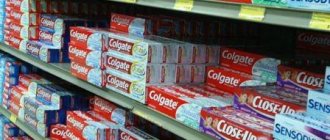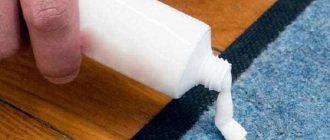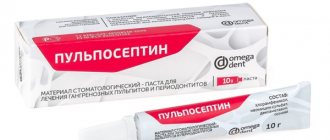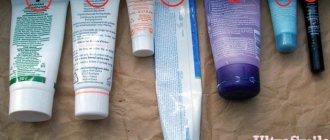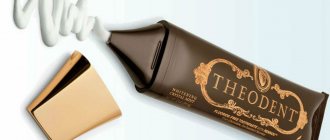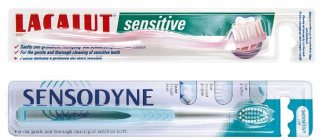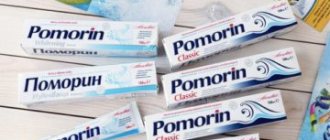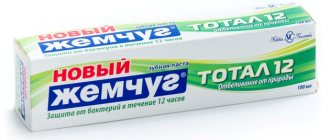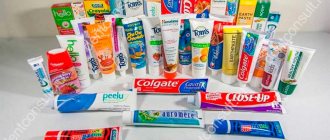Best before date
To find out this information, just carefully study the packaging; it indicates the period during which the product can be stored. Some manufacturers write until what month and year the paste can be used. And others indicate the date of production of the product and indicate during what period (months or years) it does not lose its properties. Usually this is 2–3 years. This information concerns the length of time during which the paste can be stored unopened.
But there is another shelf life for toothpaste. Once the tube is opened and the protective foil is removed, it should be used within 6-12 months. This information must also be indicated on the packaging. Usually it is applied in the form of an image of an open jar, on which there is the letter “M” and a number, which is the number of months during which the product should be used after opening.
Active ingredients in toothpaste
Most toothpastes contain five active ingredients, including fluorides, abrasives, flavoring agents or sweeteners, humectants and detergents, all of which are listed on the tube box. Thanks to saccharin or sorbitol, the paste has a pleasant sweet taste. Sodium lauryl sulfate, which is part of many cosmetic products, is a detergent that acts both as a humectant, giving toothpaste a soft consistency, and as a foaming agent for better cleaning of teeth.
Mysterious multi-colored stripes on the tube
There is an opinion that strips on toothpaste hide information about quality, composition and safety. Therefore, many buyers began to pay attention to its color, located at the adhesion site.
If you look at all the products presented, you can see that the color scheme of the stripes is not so diverse, there are only four of them.
- Green, which, according to many, including leading experts in various medical programs, indicates the natural composition of the paste. Associative thinking allows you to compare the color green with ecology and nature. This means that such a product should contain no chemical components, and the shelf life of the toothpaste should be short.
- Black is the opposite of green. It is believed that toothpaste with this label consists exclusively of chemical elements and is completely free of natural ingredients. And this category belongs to the cheapest segment, since black color indicates low-quality products.
- Red and blue stripes on toothpaste supposedly indicate that the product is of average quality. It contains approximately equal amounts of natural and artificial ingredients.
What does exp mean?
BESTBY or USE BY ('better to use before...'). After the letters the end date of the product's life is indicated. Exp on the package means the expiration date. It is also EXPIRYDATE ('expiring date').
Interesting materials:
What happens if you work at night? What happens if you wake up a bear in winter? What happens if you heat a boiled egg in the microwave? What happens if you reset your telegram account? What happens if you eat some moldy bread? What happens if you eat too much protein? What happens if you insert a cigarette into IQOS? What happens if you accidentally call the police? What happens if you mix oil with oxygen? What happens if you mix baking soda and lemon?
Why can't the color of the strip serve as a guide?
If you follow this logic, then toothpastes with a green stripe should cost significantly more than those with a black stripe. When conducting a comparative analysis of the assortment range, such a pattern is not visible.
If this statement is taken as an axiom, then the shelf life of toothpaste should be different for products with black and green labels, since natural products always have a shorter shelf life. But if you compare products with markings of different colors, this is not confirmed.
The paradoxical nature of the idea that color matters also becomes apparent after analyzing tubes of children's toothpaste. The black stripe on them is very common. But it is difficult to suspect manufacturers that they will produce dangerous and low-quality products for small consumers. This category of goods is subject to increased requirements for certification.
Factory marking
Each toothpaste that has passed the necessary certification has a factory marking on the tube indicating the production date and the maximum permissible shelf life. This parameter is valid only for a tube that has not been opened.
When the tube is opened, the period of use is reduced to 1-6 months from the moment the protective foil is removed.
The shelf life of toothpaste depends on its composition.
Products containing a large number of chemical elements are stored for as long as possible without losing their cleaning properties. More than 90% of teeth cleaning products on the market belong to this group. They can be hygienic, preventive or therapeutic. They usually contain preservatives and fluoride.
A sealed, natural-based cleanser can be stored for 1-3 years. It contains no fluorine, artificial colors, foaming substances, or flavors. Storage after opening the tube is limited to 2 months. Combined type products can be stored for up to 3 years when sealed and up to 6 months after opening.
Children's toothpaste has a special composition that rarely allows it to be stored for more than 1 year. Once opened it must be used within 1 month.
What are the strips for?
Color coding is required for production. It serves as a guide for machines that operate in automatic mode. Using these strips, they can determine the location of the adhesion or what type of paste should be poured into a particular tube. Since the packaging is not completely white and contains graphic images, it must be a contrasting color for the sensor to recognize the markings. That is why toothpaste for children, the tube of which is very bright and contains many drawings, is often marked with a black stripe.
Rules for brushing with Blend-a-med Pro-Expert toothpaste
According to all the rules, brushing Blendamed teeth should be done after each food item enters the oral cavity. If this turns out to be unattainable, then cleaning must be done twice - in the morning and in the evening. To brush your teeth with Blendamed paste, you need to get a brush with soft bristles. The time indicated for the effective use of Blendamed is at least 2 minutes, it is distributed over half a minute for each segment of the oral cavity (upper - right and left, as well as lower - right and left). You can use a timer to be sure that you are using Blendamed toothpaste correctly.
Technically, the process can be described as follows:
- It is better to start brushing from the top surface and move along the teeth, holding the brush at an angle of 45 degrees. Movements must be made against the gum line. Don't forget to clean the outer teeth.
- The next step is to clean the chewing surfaces. The brush is held straight and cleansing is carried out along the dentition.
- To clean the front teeth from the inner zone, the instrument must be taken vertically and manipulated with the same movements.
- Be as careful as possible around the gum line.
- Remember to brush your tongue to remove bacteria and oral odor.
What to look for when choosing toothpaste
There are Russian and international standards regulating the composition of toothpastes and their packaging. Each product must have the full name and full manufacturer information, as well as contact information. Information about the volume of the tube, storage requirements and expiration date of the toothpaste when closed and after opening should be included. The full composition must be indicated; if fluorine is present in it, then its mass fraction must be indicated. It is important that the tube is made from food-grade materials that protect the toothpaste from drying out.
Storage conditions
The storage conditions for toothpaste are described in GOST. At the same time, the storage temperature of this product is indicated in the range from 0°C to +25°C. The influence of sunlight and location near artificial heat sources lead to a rapid loss of quality of teeth-cleaning compositions.
It is not recommended to store toothpaste that will not be used in the foreseeable future in the bathroom. For it, choose a cool, dry place (for example, a pantry or cabinet shelf), where the product can maintain its quality for the entire time specified by the manufacturer.
Requirements for choosing children's toothpaste
Toothpaste for children is significantly different from that for adults. Since babies often swallow it, special requirements are placed on the safety of its composition. Therefore, for small family members it is necessary to choose products specifically designed for them. Please note that this category is divided into age categories. It also depends on the composition and proportion of active ingredients.
Tubes of children's toothpaste are smaller than those for adults. This is done due to the fact that the period of use of toothpaste after opening the package is negligible. For example, toothpaste should be used within one month. When choosing, it is important to pay attention to the fact that children's products must contain a minimum amount of fluoride, but it is advisable to choose toothpastes without it. The best toothpastes are those that have a natural composition and soft abrasives, and do a good job of cleaning teeth from plaque.
The composition and cost of toothpaste are not indicators of its shelf life. Thus, the expensive Jason paste (about 700 rubles), which has a natural composition, has a shelf life of 3 years. That is, it is the same as Blend-a-med, the price of which is significantly lower.
Shelf life of toothpaste by manufacturer
The most well-known toothpaste manufacturers indicate the following expiration dates for their products:
- Colgate - 3 years from date of production;
- Splat - 2 years;
- Aquafresh - 3 years;
- ROCS - 3 years;
- New pearls - 3 years;
- Blend – a – Med – 3 years.
As you can see, most cleaning compositions from leading companies can be stored for up to 3 years.
How to store toothpaste
Always close the tube after use and make sure there is no dried toothpaste around the spout where dust and dirt can settle. It is better to store toothpaste, like toothbrushes, in a closed cabinet, otherwise bacteria present in the bathroom air may become contaminated with hygiene items. In addition, storing it in a cabinet helps protect the paste from extreme heat, which can cause its components to begin to separate from each other and become thinner, losing effectiveness.
12) PARODONTAX TOOTHPASTE COMPOSITION
PARODONTAX TREATMENT AND PREVENTIVE TOOTHPASTE WITHOUT FLUORIDE (75 ml):
Parodontax Classic toothpaste. WITHOUT FLUORIDE. Contains 70% active ingredients. Effectively fights inflammation and bleeding gums. The high concentration of active ingredients determines the specific taste of parodontax toothpaste. Children under 6 years of age should use a pea-sized amount of toothpaste and brush under adult supervision to prevent swallowing. Use before (day, month, year) - see (EXP) on the package. PERODONTAX TOOTH PASTE COMPOSITION: Sodium Bicarbonate, Aqua, Glycerin, Cocamidopropyl Betaine, Alcohol, Krameria Triandra Extract, Echinacea Purpurea Juice, Xanthan Gum, Chamomilla Recutita Extract, Commiphora Myrrha Extract, Sodium Saccharin, Sodium Benzoate, Salvia Officinalis Oil, Mentha Piperita Oil, Mentha Arvensis Oil, Limonene, CI 77491.
Made by: Slovak Republic
10) COLGATE TOOTHPASTE COMPOSITION
ORAL CAVITY PRODUCTS “COLGATE” TRIPLE ACTION /packaging/ COLGATE ANTI-CAVITY TOOTHPASTE TREATMENT AND PREVENTIVE TOOTHPASTE 3rd ACTION (100 ml):
Colgate therapeutic and prophylactic toothpaste is intended for:
- Strong Teeth - strengthens teeth;
- White Teeth - teeth whitening;
- Fresh Breath - fresh breath.
COLGATE PASTE COMPOSITION /INGREDIENTS/colgate toothpaste composition: Aqua, Sorbitol, Hydrated Silica, Calcium Carbonate, Sodium Lauryl Sulfate, Sodium Monofluorophosphate, Aroma, Magnesium Aluminum Silicate, Cellulose Gum, Sodium Bicarbonate, Sodium Carbonate, Sodium Saccharin, Methylparaben, Propylparaben, Limonene, CI 74160, CI 74260.
Contains sodium monofluorophosphate. Mass fraction of fluoride 1.1% (1450 ppmF-).
Importer: Moscow.

